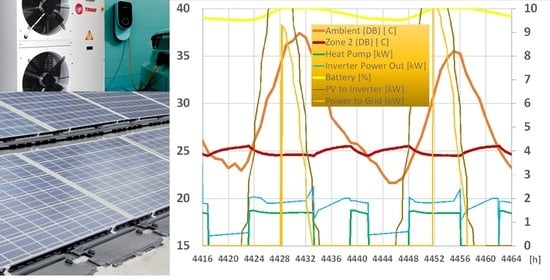Interaction of a House’s Rooftop PV System with an Electric Vehicle’s Battery Storage and Air Source Heat Pump
Abstract
:1. Introduction
2. Materials and Methods
2.1. Building Simulation Details
2.2. HVAC System Modeling Details
2.3. Electric Car Consumption and Performance Data, Batteries Simulation Details
2.4. Photovoltaic System Simulation Details
2.5. TRNSYS Types and Simulation Details
3. Results
3.1. Monthly Systems Performance and Annual Summary
3.2. Hourly Systems Performance and Interactions
4. Conclusions
Author Contributions
Funding
Acknowledgments
Conflicts of Interest
Appendix A
| Shell Type | Layers | U (W/m2K) |
|---|---|---|
| Roof insulation | Reinforced concrete slab, extruded polystyrene, lightweight concrete, ceramic tiles | 0.293 |
| Concrete column | Reinforced concrete, extruded polystyrene | 0.334 |
| Outside Wall | Ceramic brick, extruded polystyrene, ceramic brick | 0.313 |
| Floor insulation | Reinforced concrete slab, extruded polystyrene | 0.564 |
| Heating Mode | Outdoor Ambient Temperature (°C) | ||||||||||||
|---|---|---|---|---|---|---|---|---|---|---|---|---|---|
| 18.0 | 15.0 | 13.0 | 10.0 | 8.5 | 7.0 | 4.5 | 2.0 | 0.0 | −3.0 | −6.0 | −8.0 | −10.0 | |
| KW | 1.17 | 1.14 | 1.12 | 1.10 | 1.08 | 1.07 | 1.05 | 1.04 | 1.03 | 1.02 | 1.00 | 0.98 | 0.96 |
| COP | 5.8 | 5.6 | 5.4 | 5.2 | 5.0 | 4.9 | 4.6 | 4.4 | 4.2 | 4.0 | 3.8 | 3.6 | 3.5 |
| kW thermal | 6.79 | 6.38 | 6.05 | 5.72 | 5.40 | 5.24 | 4.83 | 4.55 | 4.32 | 4.08 | 3.80 | 3.53 | 3.36 |
| Cooling Mode | Outdoor Ambient Temperature (°C) | ||||||||||||
| 29.4 | 35.0 | 40.6 | 46.1 | ||||||||||
| kW thermal | 5.61 | 5.26 | 5.28 | 5.39 | |||||||||
| kW | 1.7 | 1.95 | 2.2 | 2.45 | |||||||||
| EER | 11.3 | 9.3 | 8.3 | 7.4 | |||||||||
| COP | 3.3 | 2.7 | 2.4 | 2.2 | |||||||||
| Parameter | Value |
|---|---|
| DC input side (PV generator) | - |
| Maximum input voltage | 845 V |
| Minimum input voltage | 350 V |
| Number of MPP tracker | 1 |
| Maximum input current | 32 A |
| Maximum input power at maximum active output power | 10,800 W |
| Maximum recommended PV power | 12,500 W |
| AC output side (grid connection) | - |
| Grid voltage | 320 V, …, 480 V |
| Rated grid voltage | 400 V |
| Maximum output current | 16 A |
| Maximum active power (cos φ = 0.95) | 9800 W |
| Maximum apparent power (cos φ = 0.95) | 10,300 VA |
| Rated frequency | 50 Hz |
| Night-time power loss | <2.5 W |
| Distortion factor (cos φ = 1) | <3% |
| Power factor cos φ | 0.95 capacitive, 0.95 inductive |
| Maximum efficiency | 96.3% |
| MPP efficiency | >99% |
| Standby power | 9 W |
References
- EEA. New Registrations of Electric Vehicles in Europe; European Environment Agency: Brussels, Belgium, 2021; Available online: https://www.eea.europa.eu/ims/new-registrations-of-electric-vehicles (accessed on 6 April 2022).
- EPA. Final Rule: Revised 2023 and Later Model Year Light-Duty Vehicle Greenhouse Gas Emissions Standards; EPA: Washington, DC, USA, 2021; Volume 86.
- European Commission. The European Green Deal; COM(2019) 640 Final, Brussels, 11.12.2019; European Union, Ed.; European Commission: Brussels, Belgium, 2019. [Google Scholar]
- EU. Regulation (EU) 2019/631 of the European Parliament and of the Council, Setting CO2 Emission Performance Standards for New Passenger Cars and for New Light Commercial Vehicles; European Commission: Brussels, Belgium, 2019. [Google Scholar]
- EU. Climate Action: Transport Emissions—A European Strategy for Low-Emission Mobility; European Commission: Brussels, Belgium, 2021; Available online: https://ec.europa.eu/clima/eu-action/transport-emissions_en (accessed on 12 January 2022).
- Tiseo, I. Distribution of Carbon Dioxide Emissions Produced by the Transportation Sector Worldwide in 2020, by Subsector. Available online: https://www.statista.com/statistics/1185535/transport-carbon-dioxide-emissions-breakdown/ (accessed on 12 January 2022).
- Osório, G.J.; Gough, M.; Lotfi, M.; Santos, S.F.; Espassandim, H.M.; Shafie-khah, M.; Catalão, J.P. Rooftop photovoltaic parking lots to support electric vehicles charging: A comprehensive survey. Int. J. Electr. Power Energy Syst. 2021, 133, 107274. [Google Scholar] [CrossRef]
- Dik, A.; Omer, S.; Boukhanouf, R. Electric Vehicles: V2G for Rapid, Safe, and Green EV Penetration. Energies 2022, 15, 803. [Google Scholar] [CrossRef]
- Economist. A Lack of Chargers Could Stall the Electric-Vehicle Revolution. 2021. Available online: https://www.economist.com/business/a-lack-of-chargers-could-stall-the-electric-vehicle-revolution/21806663 (accessed on 12 January 2022).
- GOV.UK. PM to Announce Electric Vehicle Revolution. 2021. Available online: https://www.gov.uk/government/news/pm-to-announce-electric-vehicle-revolution (accessed on 27 January 2022).
- Funke, S.Á.; Sprei, F.; Gnann, T.; Plötz, P. How much charging infrastructure do electric vehicles need? A review of the evidence and international comparison. Transp. Res. Part D Transp. Environ. 2019, 77, 224–242. [Google Scholar] [CrossRef]
- Nicholas, M.; Lutsey, N. Quantifying the Electric Vehicle Charging Infrastructure Gap in the United Kingdom; ICCT: London, UK, 2020. [Google Scholar]
- Dreisbusch, M.; Mang, S.; Ried, S.; Kellerer, F.; Pfab, X. Regulation of Grid-Efficient Charging from the User’s Perspective; MTZ Worldwide: Wiesbaden, Germany, 2020; Volume 81, pp. 66–70. [Google Scholar]
- Engel, H.; Hensley, R.; Knupfer, S.; Sahdev, S. The Potential Impact of Electric Vehicles on Global Energy Systems; McKinsey Center for Future Mobility: Atlanta, GA, USA, 2018. [Google Scholar]
- Fachrizal, R.; Shepero, M.; Åberg, M.; Munkhammar, J. Optimal PV-EV sizing at solar powered workplace charging stations with smart charging schemes considering self-consumption and self-sufficiency balance. Appl. Energy 2021, 307, 118139. [Google Scholar] [CrossRef]
- Bhatti, A.R.; Salam, Z.; Aziz, M.J.B.A.; Yee, K.P. A critical review of electric vehicle charging using solar photovoltaic. Int. J. Energy Res. 2016, 40, 439–461. [Google Scholar] [CrossRef]
- Alkawsi, G.; Baashar, Y.; Abbas U, D.; Alkahtani, A.A.; Tiong, S.K. Review of Renewable Energy-Based Charging Infrastructure for Electric Vehicles. Appl. Sci. 2021, 11, 3847. [Google Scholar] [CrossRef]
- Gupta, J.; Singh, B.; Kushwaha, R. A Rooftop Solar PV Assisted On-Board Enhanced Power Quality Charging System for E-Rickshaw. In 2020 International Conference on Power, Instrumentation, Control and Computing (PICC); IEEE: Piscataway, NJ, USA, 2020. [Google Scholar]
- Martin, H.; Buffat, R.; Bucher, D.; Hamper, J.; Raubal, M. Using rooftop photovoltaic generation to cover individual electric vehicle demand—A detailed case study. Renew. Sustain. Energy Rev. 2022, 157, 111969. [Google Scholar] [CrossRef]
- Love, J.; Smith, A.Z.; Watson, S.; Oikonomou, E.; Summerfield, A.; Gleeson, C.; Biddulph, P.; Chiu, L.F.; Wingfield, J.; Martin, C.; et al. The addition of heat pump electricity load profiles to GB electricity demand: Evidence from a heat pump field trial. Appl. Energy 2017, 204, 332–342. [Google Scholar] [CrossRef]
- Renault. The Energy Efficiency of An Electric Car Motor; Groupe Renault: Boulogne-Billancourt, France, 2021; Available online: https://www.renaultgroup.com/en/news-on-air/news/the-energy-efficiency-of-an-electric-car-motor/ (accessed on 12 January 2022).
- European Commission. Directive 2010/31/EU of the European Parliament and of the Council of 19 May 2010 on the Energy Performance of Buildings. Amended by: Directive (EU) 2018/844 of the European Parliament and of the Council of 30 May 2018 and Regulation (EU) 2018/1999 of the European Parliament and of the Council of 11 December 2018; Office for Official Publications of the European Communities: Luxembourg, 2018. [Google Scholar]
- Angelopoulos, A.; Ktena, A.; Manasis, C.; Voliotis, S. Impact of a Periodic Power Source on a RES Microgrid. Energies 2019, 12, 1900. [Google Scholar] [CrossRef] [Green Version]
- Mele, E.D.; Elias, C.; Ktena, A. Machine Learning Platform for Profiling and Forecasting at Microgrid Level. Electr. Control. Commun. Eng. 2019, 15, 21–29. [Google Scholar] [CrossRef] [Green Version]
- Schlachtberger, D.P.; Brown, T.; Schramm, S.; Greiner, M. The benefits of cooperation in a highly renewable European electricity network. Energy 2017, 134, 469–481. [Google Scholar] [CrossRef] [Green Version]
- Cebulla, F.; Naegler, T.; Pohl, M. Electrical energy storage in highly renewable European energy systems: Capacity requirements, spatial distribution, and storage dispatch. J. Energy Storage 2017, 14, 211–223. [Google Scholar] [CrossRef] [Green Version]
- EEE. Residential Building Electrification in California. Consumer Economics, Greenhouse Gases and Grid Impacts; Energy and Environmental Economics, Inc.: San Francisco, CA, USA, 2019. [Google Scholar]
- Protopapadaki, C.; Saelens, D. Heat pump and PV impact on residential low-voltage distribution grids as a function of building and district properties. Appl. Energy 2017, 192, 268–281. [Google Scholar] [CrossRef]
- Bagalini, V.; Zhao, B.Y.; Wang, R.Z.; Desideri, U. Solar PV-Battery-Electric Grid-Based Energy System for Residential Applications: System Configuration and Viability. Research 2019, 2019, 3838603. [Google Scholar] [CrossRef] [Green Version]
- Sørensen, Å.L.; Lindberg, K.B.; Sartori, I.; Andresen, I. Analysis of residential EV energy flexibility potential based on real-world charging reports and smart meter data. Energy Build. 2021, 241, 110923. [Google Scholar] [CrossRef]
- Doroudchi, E.; Alanne, K.; Okur, Ö.; Kyyrä, J.; Lehtonen, M. Approaching net zero energy housing through integrated EV. Sustain. Cities Soc. 2018, 38, 534–542. [Google Scholar] [CrossRef] [Green Version]
- EU. 2021/0197 (COD); Proposal for a Regulation of the European Parliament and of the Council Amending Regulation (EU) 2019/631 as Regards Strengthening the CO2 Emission Performance Standards for New Passenger Cars and New Light Commercial Vehicles in Line with the Union’s Increased Climate Ambition. EU: Brussels, Belgium, 2021.
- The White House. President Biden Outlines Target of 50% Electric Vehicle Sales Share in 2030 to Unleash Full Economic Benefits of Build Back Better Agenda and Advance Smart Fuel Efficiency and Emission Standards. 2021. Available online: https://www.whitehouse.gov/briefing-room/statements-releases/2021/08/05/fact-sheet-president-biden-announces-steps-to-drive-american-leadership-forward-on-clean-cars-and-trucks/ (accessed on 18 January 2022).
- Zhen Huang, W.; Zaheeruddin, M.; Cho, S.H. Dynamic simulation of energy management control functions for HVAC systems in buildings. Energy Convers. Manag. 2006, 47, 926–943. [Google Scholar] [CrossRef]
- Stamatellos, G.; Zogou, O.; Stamatelos, A. Energy Performance Optimization of a House with Grid-Connected Rooftop PV Installation and Air Source Heat Pump. Energies 2021, 14, 740. [Google Scholar] [CrossRef]
- Zogou, O.; Stamatelos, A. Optimization of thermal performance of a building with ground source heat pump system. Energy Convers. Manag. 2007, 48, 2853–2863. [Google Scholar] [CrossRef]
- Safa, A.A.; Fung, A.S.; Kumar, R. Comparative thermal performances of a ground source heat pump and a variable capacity air source heat pump systems for sustainable houses. Appl. Therm. Eng. 2015, 81, 279–287. [Google Scholar] [CrossRef]
- NN. TRNSYS 16 Manual; Solar Energy Laboratory, University of Wisconsin-Madison: Madison, WI, USA, 2005. [Google Scholar]
- Nayak, A.K.; Hagishima, A. Modification of building energy simulation tool TRNSYS for modelling nonlinear heat and moisture transfer phenomena by TRNSYS/MATLAB integration. EDP Sci. 2020, 172, 25009. [Google Scholar] [CrossRef]
- Wang, L.; Gwilliam, J.; Jones, P. Case study of zero energy house design in UK. Energy Build. 2009, 41, 1215–1222. [Google Scholar] [CrossRef]
- Mazzeo, D.; Matera, N.; Cornaro, C.; Oliveti, G.; Romagnoni, P.; De Santoli, L. EnergyPlus, IDA ICE and TRNSYS predictive simulation accuracy for building thermal behaviour evaluation by using an experimental campaign in solar test boxes with and without a PCM module. Energy Build. 2020, 212, 109812. [Google Scholar] [CrossRef]
- Almeida, P.; Carvalho, M.J.; Amorim, R.; Mendes, J.F.; Lopes, V. Dynamic testing of systems—Use of TRNSYS as an approach for parameter identification. Sol. Energy 2014, 104, 60–70. [Google Scholar] [CrossRef] [Green Version]
- Chargui, R.; Sammouda, H. Modeling of a residential house coupled with a dual source heat pump using TRNSYS software. Energy Convers. Manag. 2014, 81, 384–399. [Google Scholar] [CrossRef]
- Safa, A.A.; Fung, A.S.; Kumar, R. Heating and cooling performance characterisation of ground source heat pump system by testing and TRNSYS simulation. Renew. Energy 2015, 83, 565–575. [Google Scholar] [CrossRef]
- Neymark, J.; Judkoff, R.; Knabe, G.; Le, H.T.; Dürig, M.; Glass, A.; Zweifel, G. Applying the building energy simulation test (BESTEST) diagnostic method to verification of space conditioning equipment models used in whole-building energy simulation programs. Energy Build. 2002, 34, 917–931. [Google Scholar] [CrossRef]
- Standard 140-2001; Standard Method of Test for the Evaluation of Building Energy Analysis Computer Programs. ASHRAE: Atlanta, GA, USA, 2001.
- Trane. Picco 6-16 kW Air-to-Water Heat Pumps with Inverter-Driven Scroll Compressors 2019. Available online: https://www.trane.com/commercial/europe/no/en/products-systems/equipment/heat-pumps/air-to-water/Picco-heat-pump.html (accessed on 12 November 2021).
- NN. T.E.S.S. Component Libraries for TRNSYS; Version 2.0. User’s Manual; University of Wisconsin: Madison, WI, USA, 2004; Available online: http://www.tess-inc.com/services/software (accessed on 12 December 2020).
- Saldaña, G.; San Martín, J.I.; Zamora, I.; Asensio, F.J.; Oñederra, O. Analysis of the Current Electric Battery Models for Electric Vehicle Simulation. Energies 2019, 12, 2750. [Google Scholar] [CrossRef] [Green Version]
- Meng, J.; Luo, G.; Ricco, M.; Swierczynski, M.; Stroe, D.I.; Teodorescu, R. Overview of Lithium-Ion Battery Modeling Methods for State-of-Charge Estimation in Electrical Vehicles. Appl. Sci. 2018, 8, 659. [Google Scholar] [CrossRef] [Green Version]
- Hussein, A.A.; Batarseh, I. An Overview of Generic Battery Models. In 2011 IEEE Power and Energy Society General Meeting; IEEE: Piscataway, NY, USA, 2011. [Google Scholar]
- AE. AE-A-Series EV Charger. 2022. Available online: https://www.ae-electronics.com/ (accessed on 12 November 2021).
- Sharp. 370 Wp/Mono: NUJC370 Data Sheet. 2020. Available online: https://www.sharp.co.uk/cps/rde/xbcr/documents/documents/Marketing/Datasheet/2004_NUAC300B_Mono_Datasheet_EN.pdf (accessed on 18 January 2022).
- De Soto, W.; Klein, S.A.; Beckman, W.A. Improvement and validation of a model for photovoltaic array performance. Sol. Energy 2006, 80, 78–88. [Google Scholar] [CrossRef]
- California_ISO. What the Duck Curve Tells Us about Managing A Green Grid. 2016. Available online: http://www.caiso.com/Documents/FlexibleResourcesHelpRenewables_FastFacts.pdf (accessed on 12 December 2021).
- ANSI/ASHRAE Standard 62.2-2004; Ventilation and Acceptable Indoor Air Quality in Low-rise Residential Buildings. ASHRAE: Washington, DC, USA, 2004; p. 18.
- STECA. StecaGrid-10000+ 3-ph Technical-Data. 2021. Available online: https://www.photovoltaic.gr/public/media/upload-files/Steca/StecaGrid_8000plus_3ph_10000plus_3ph_specification_EN_3.pdf (accessed on 12 January 2022).
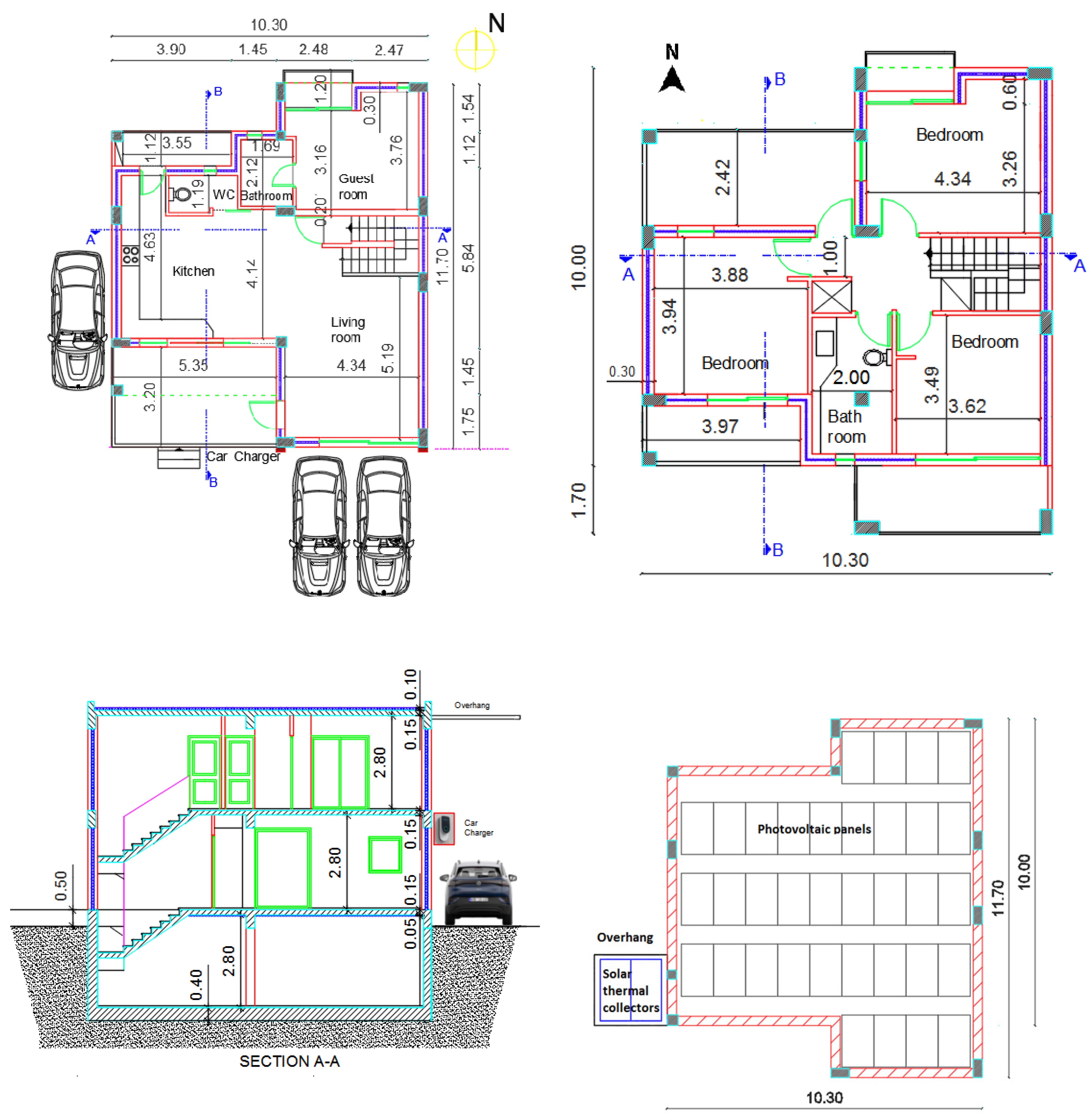
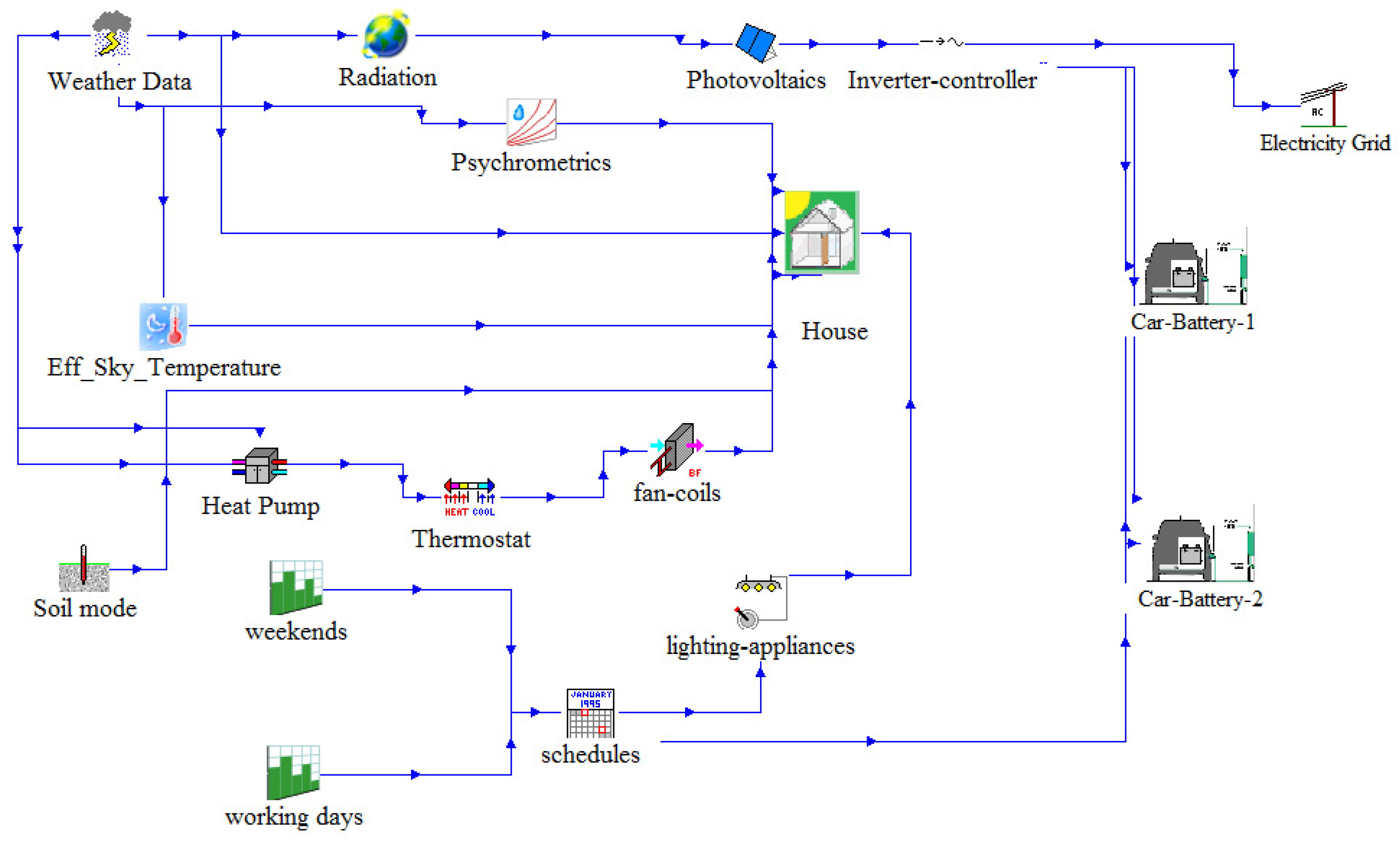
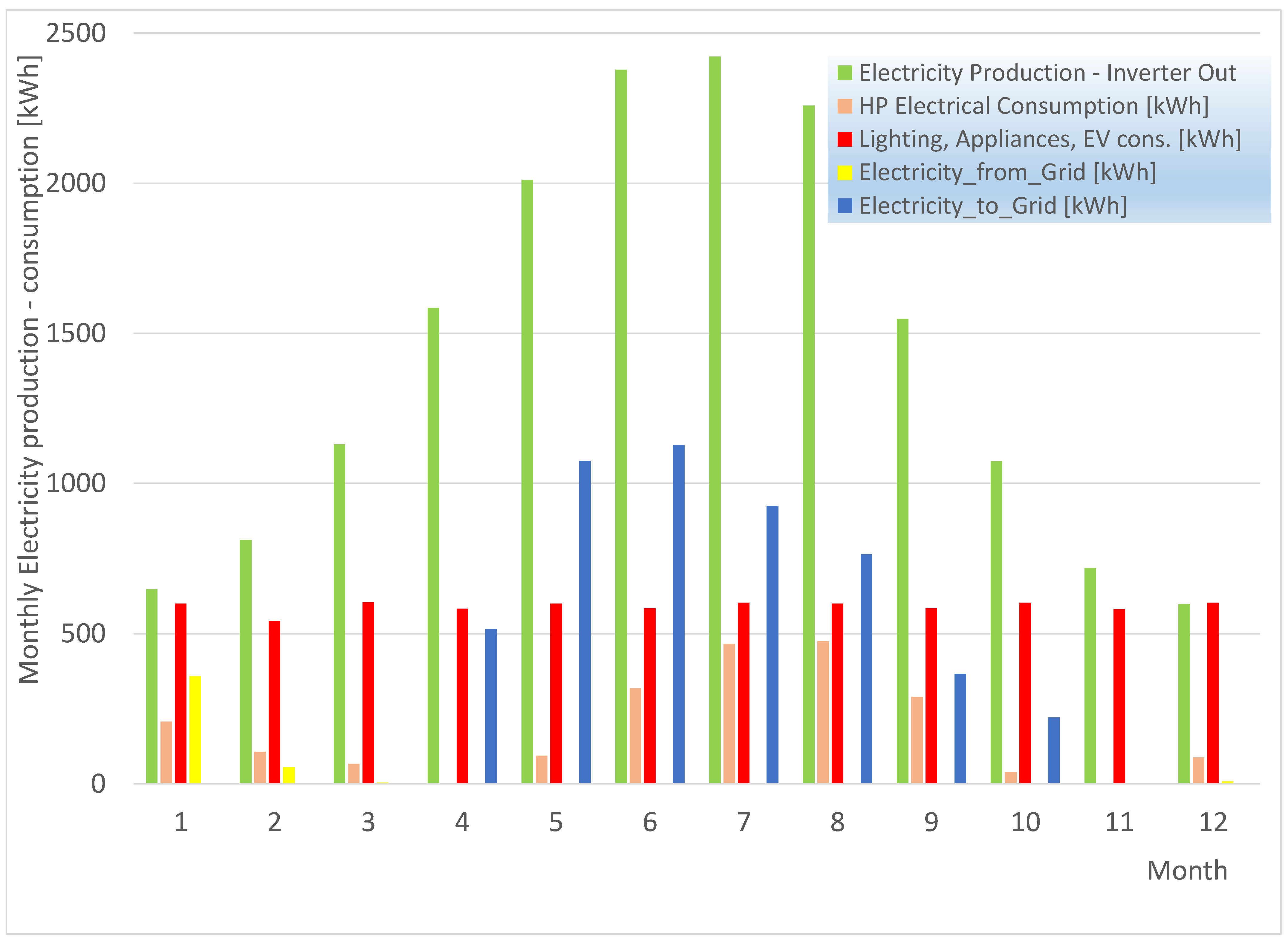
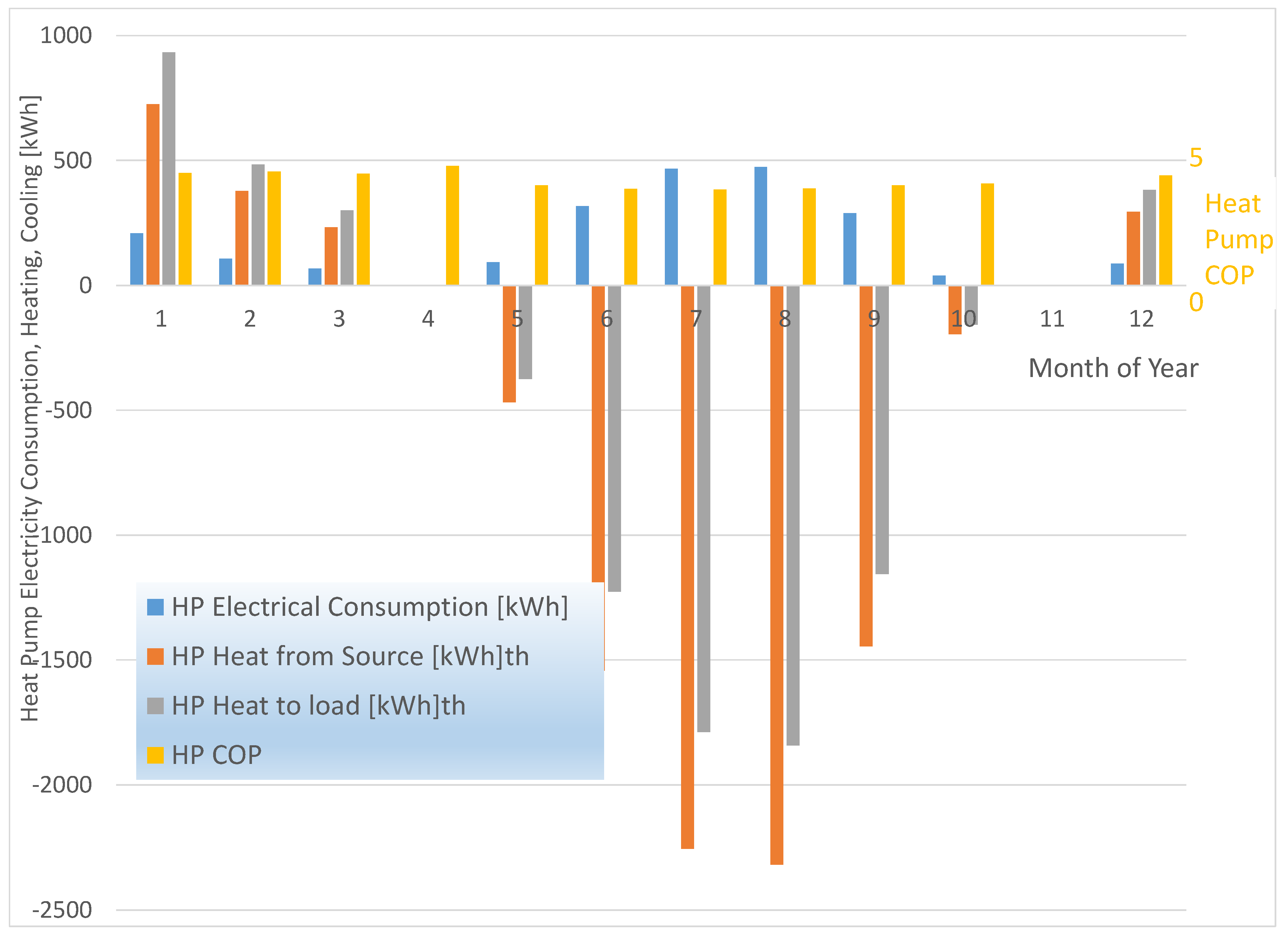
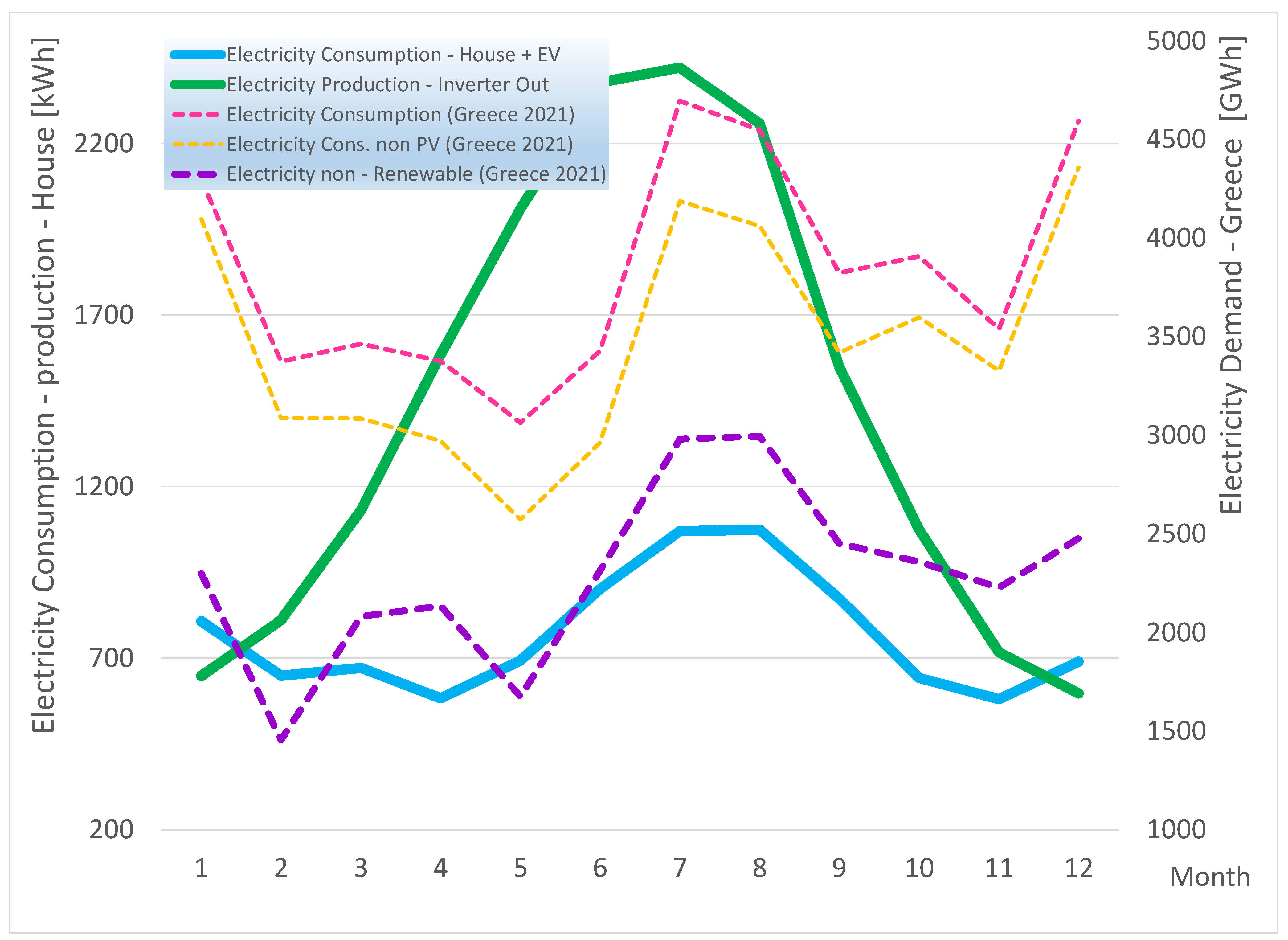
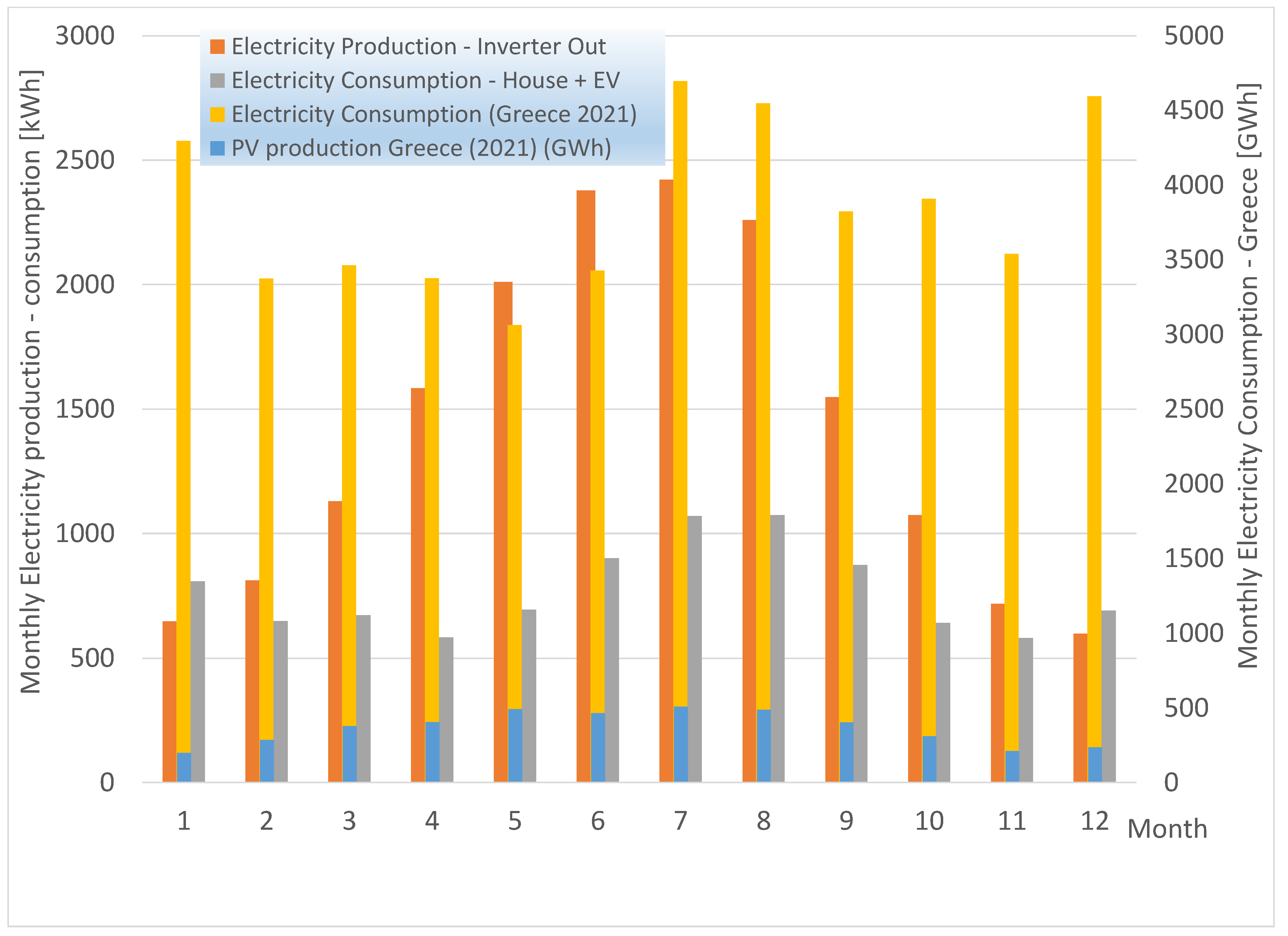
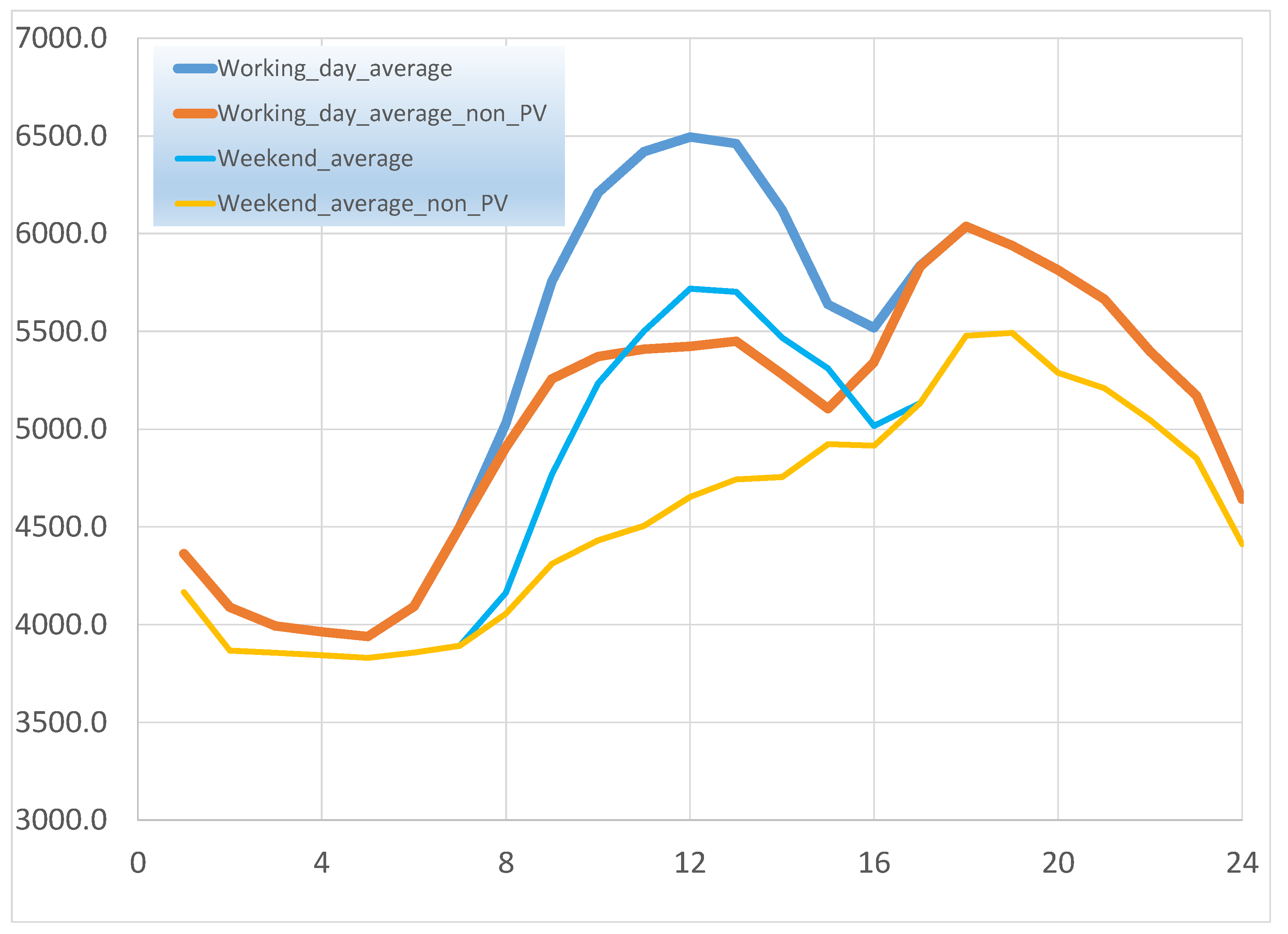
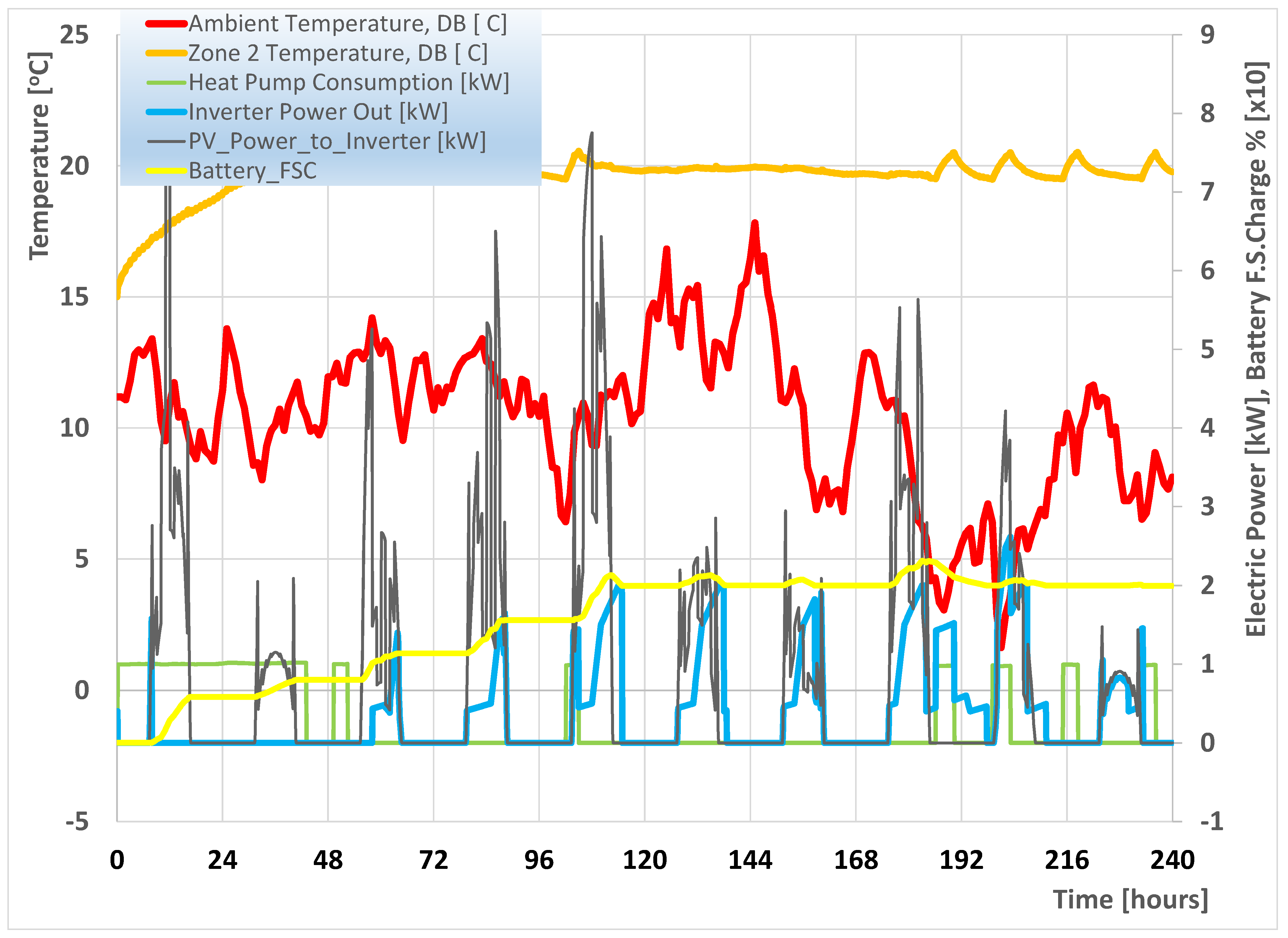
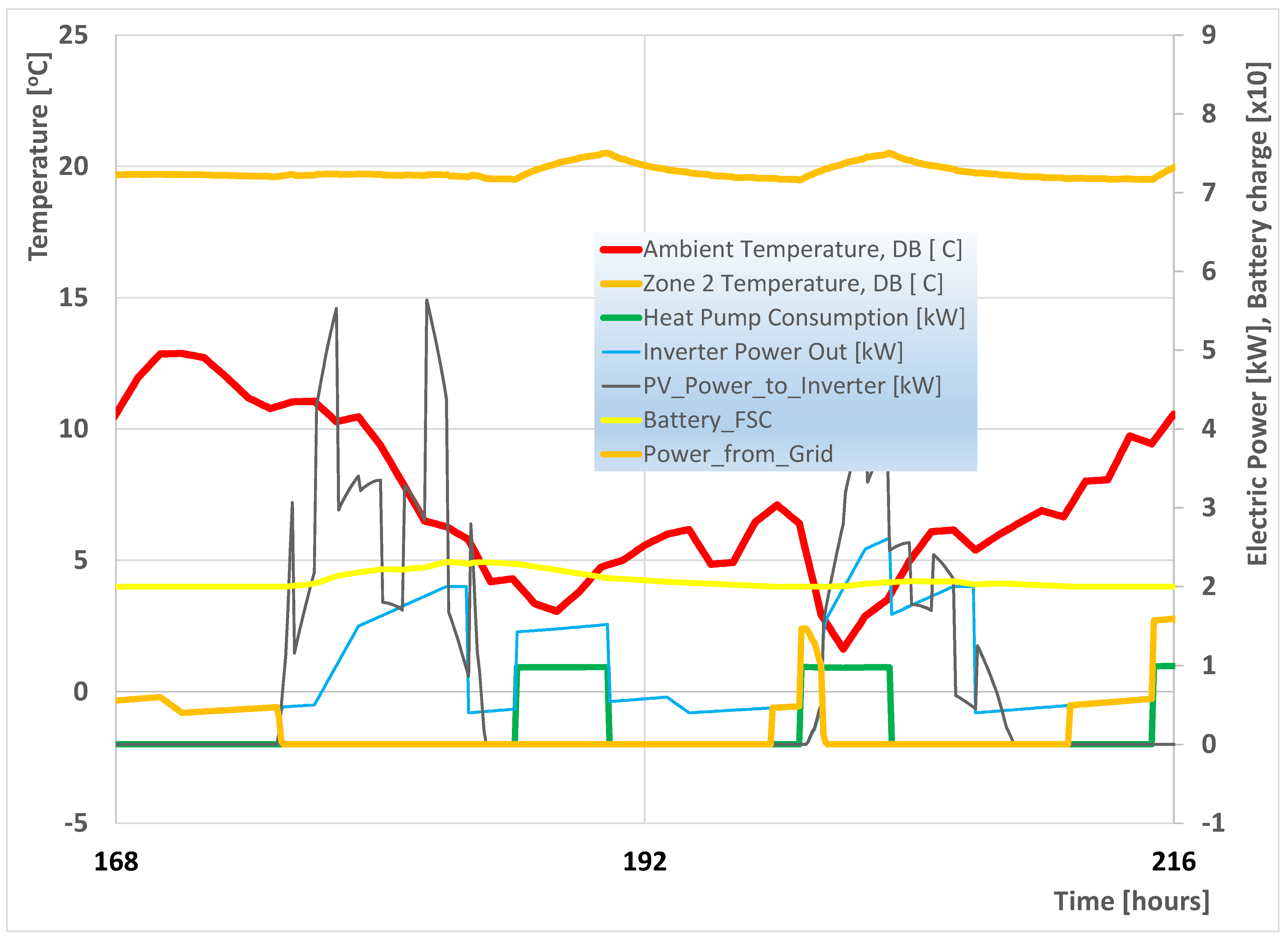
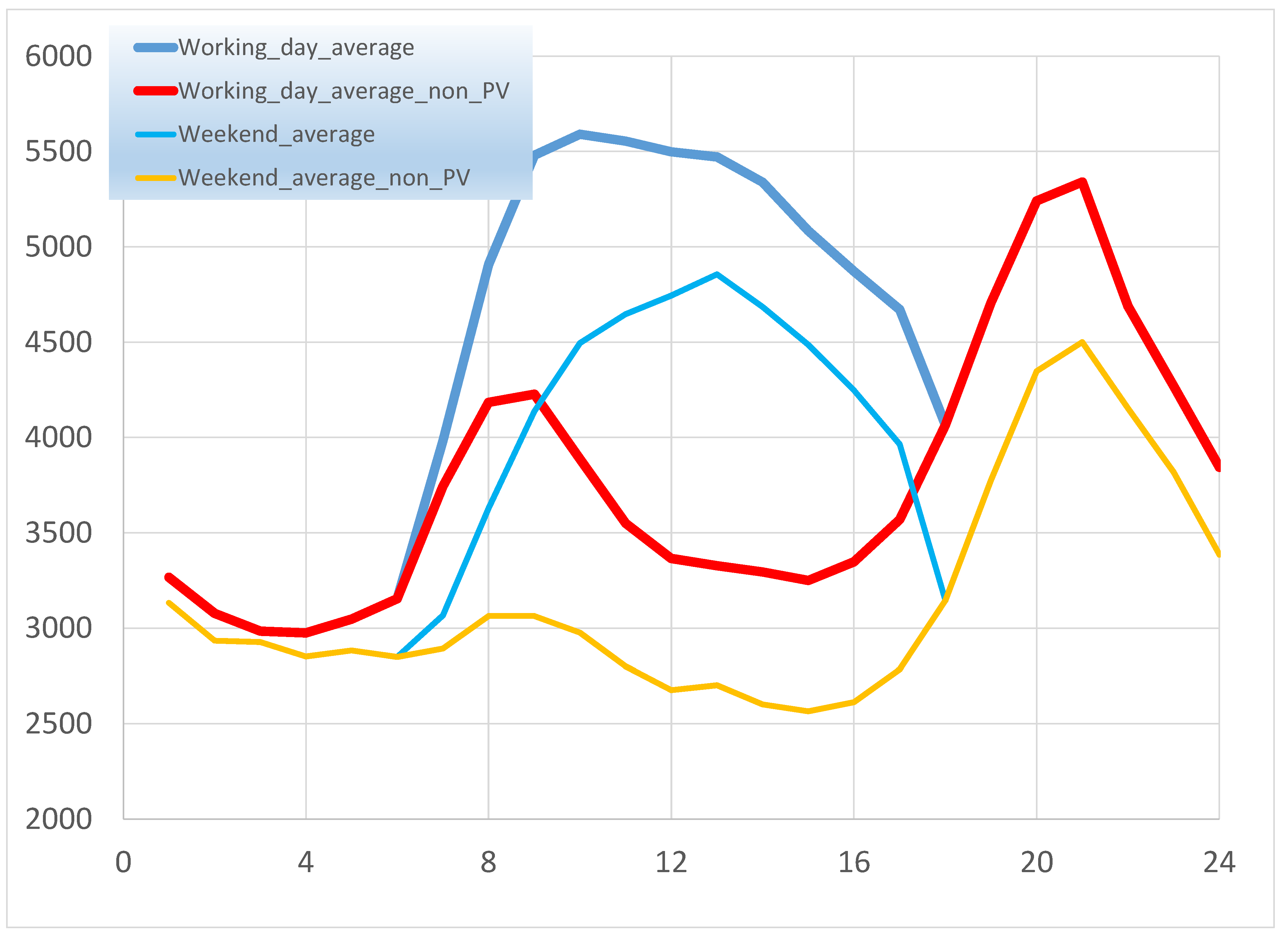

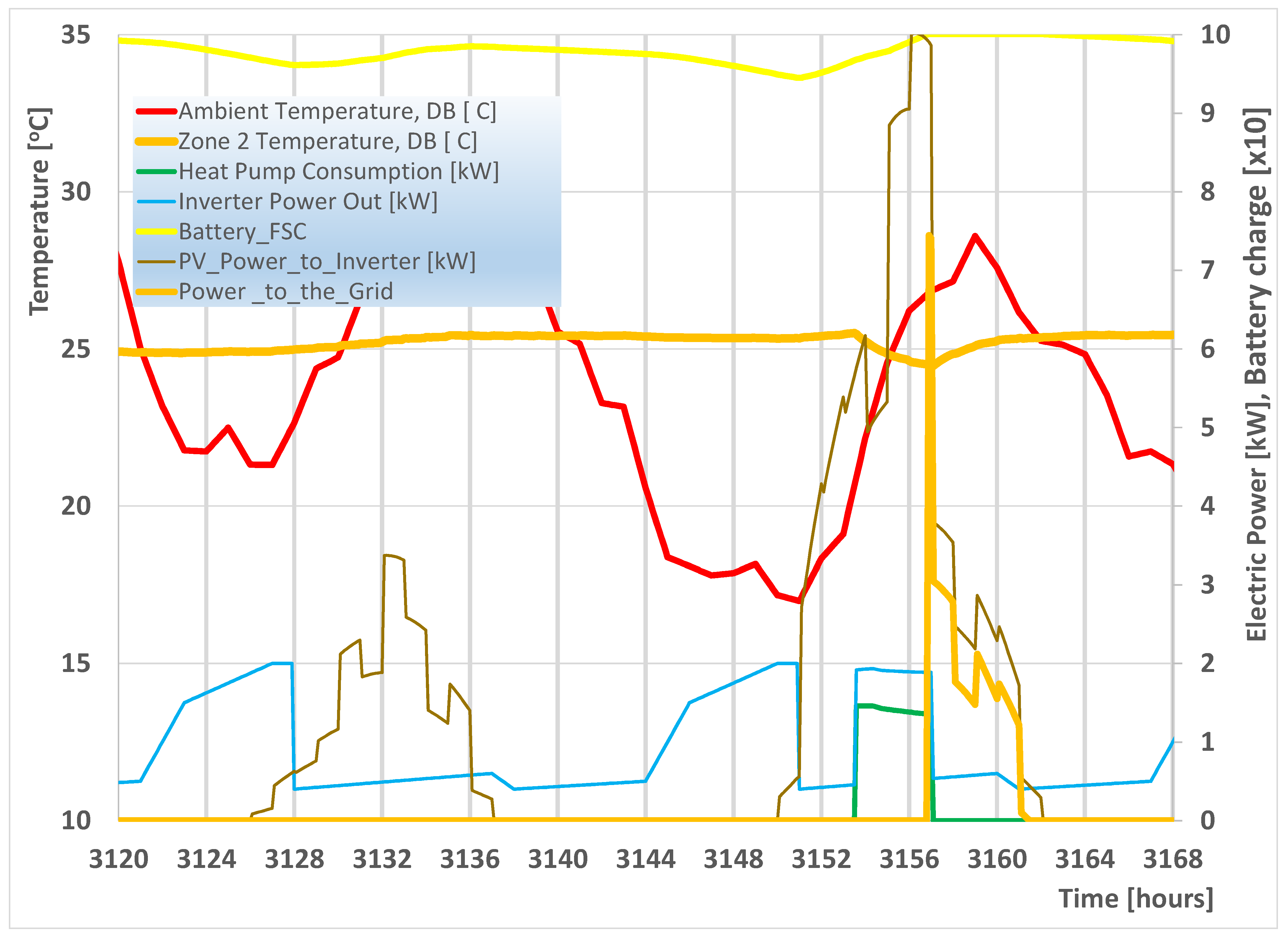

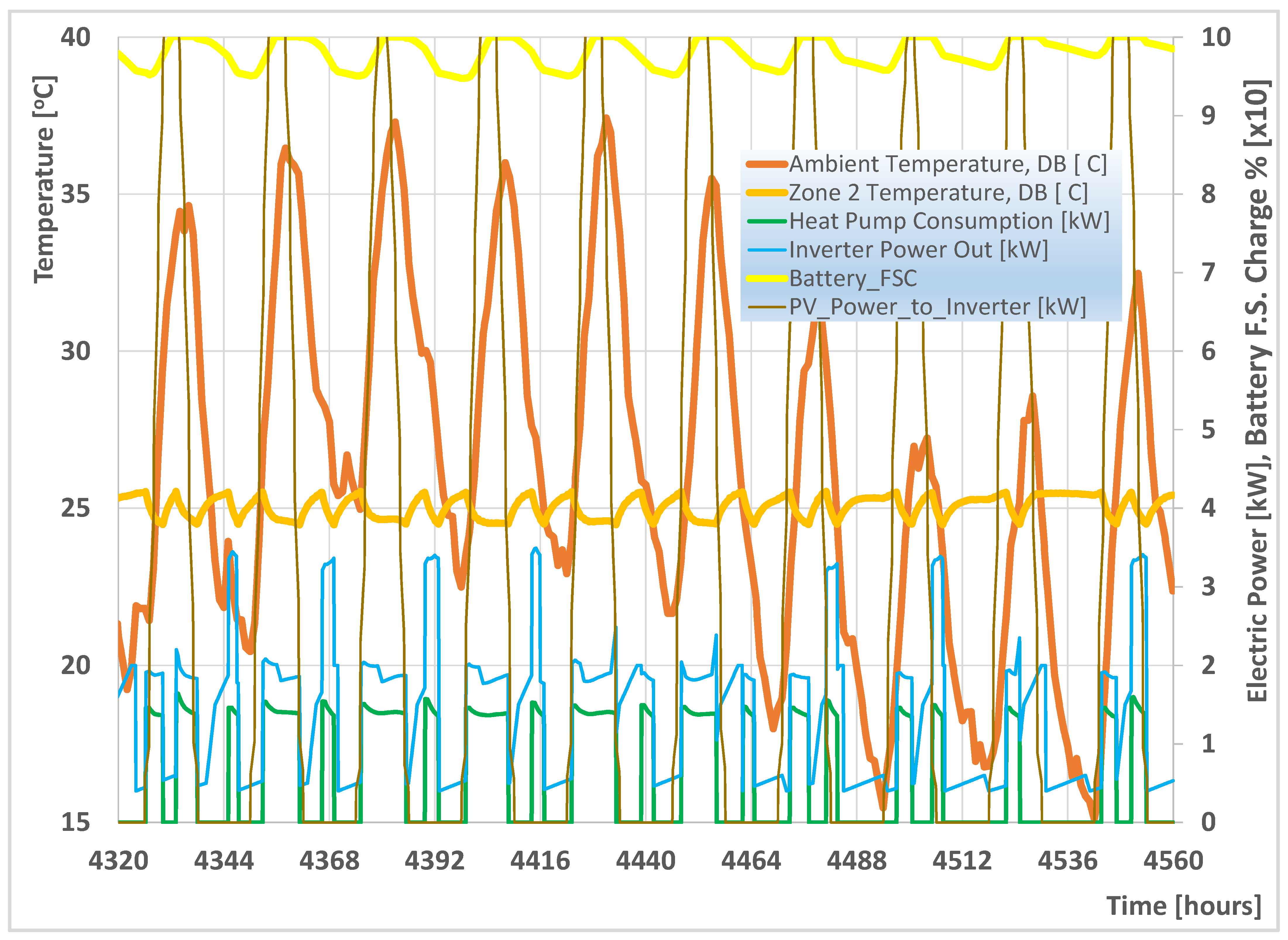
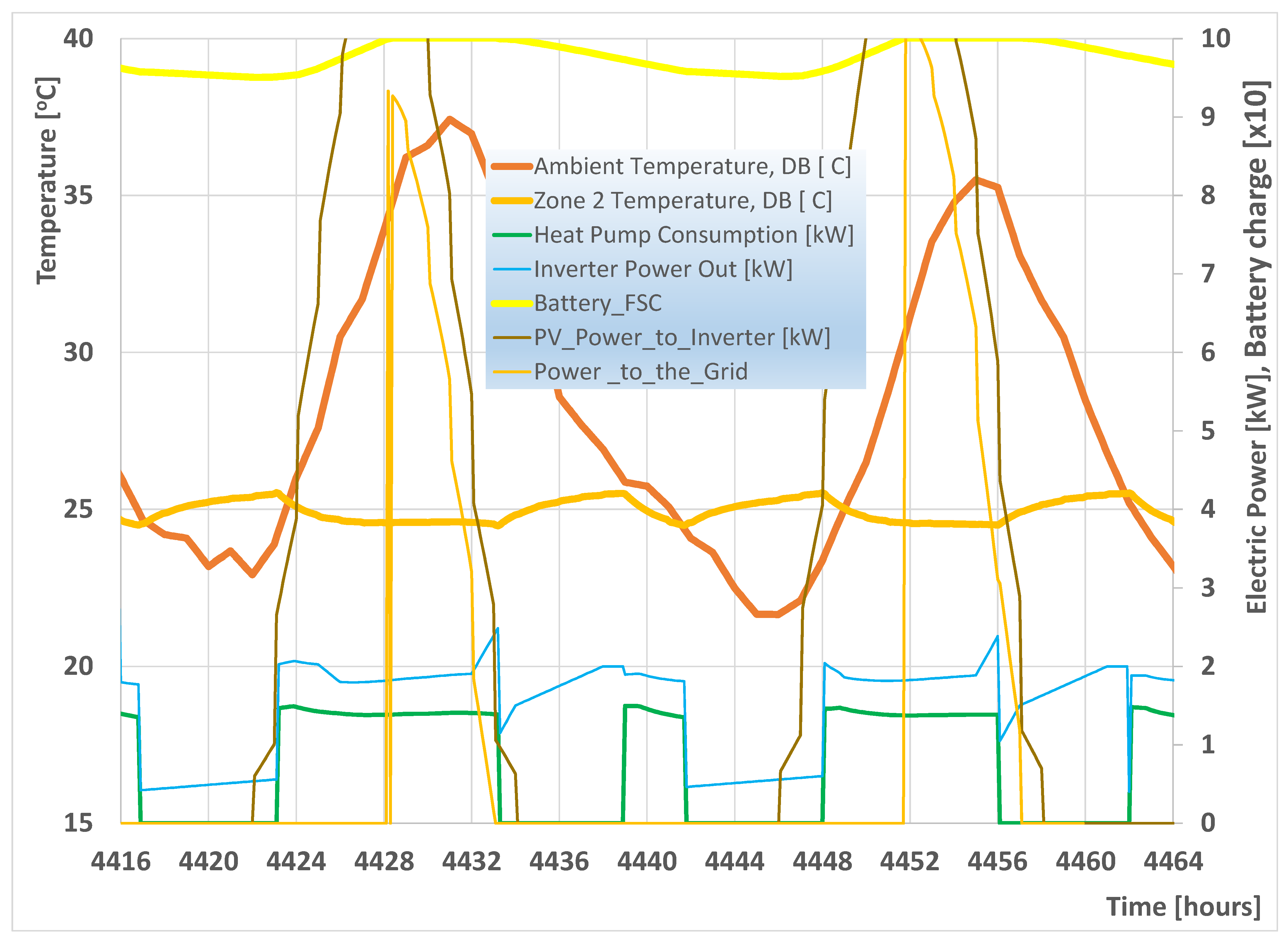
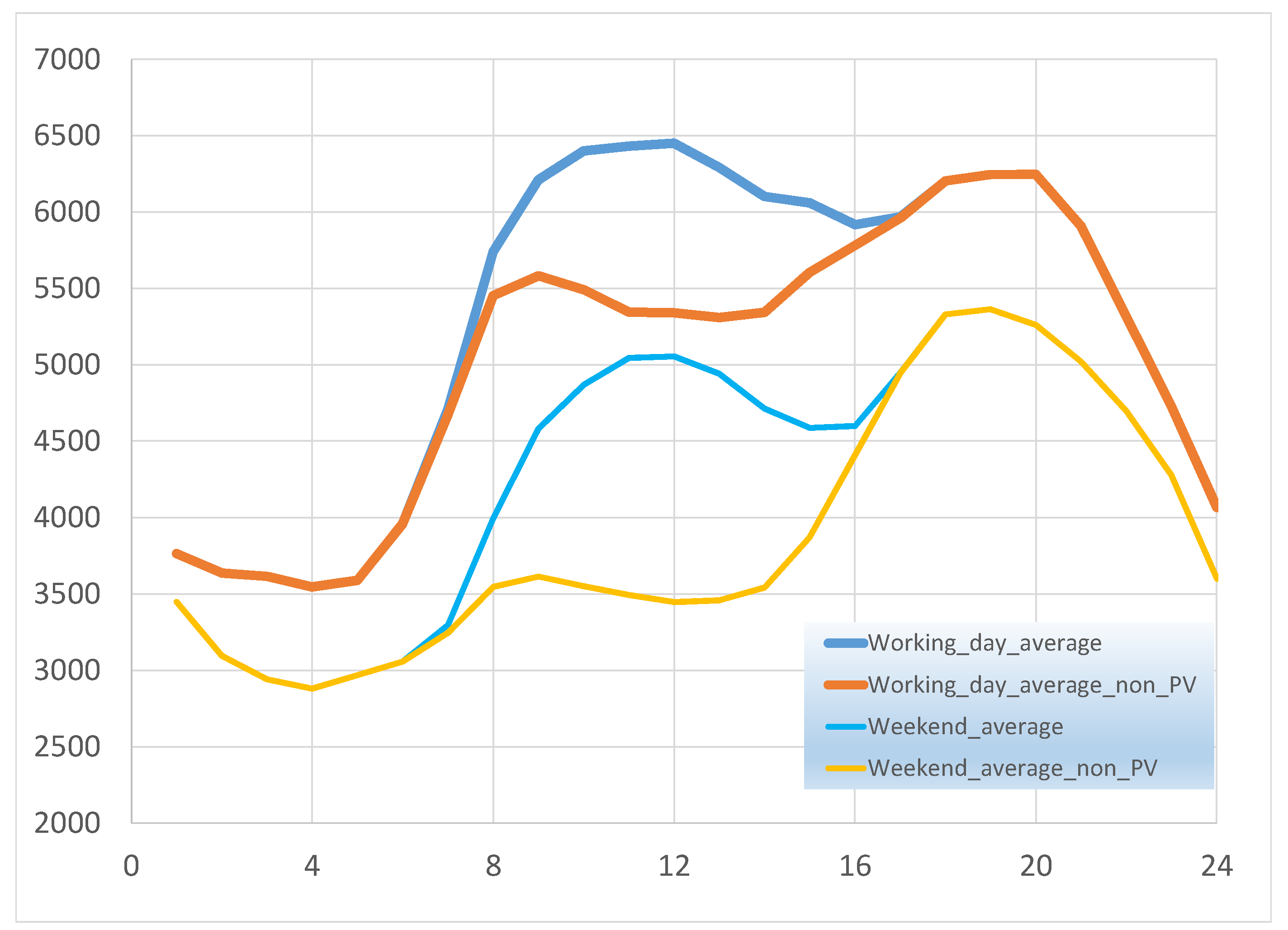

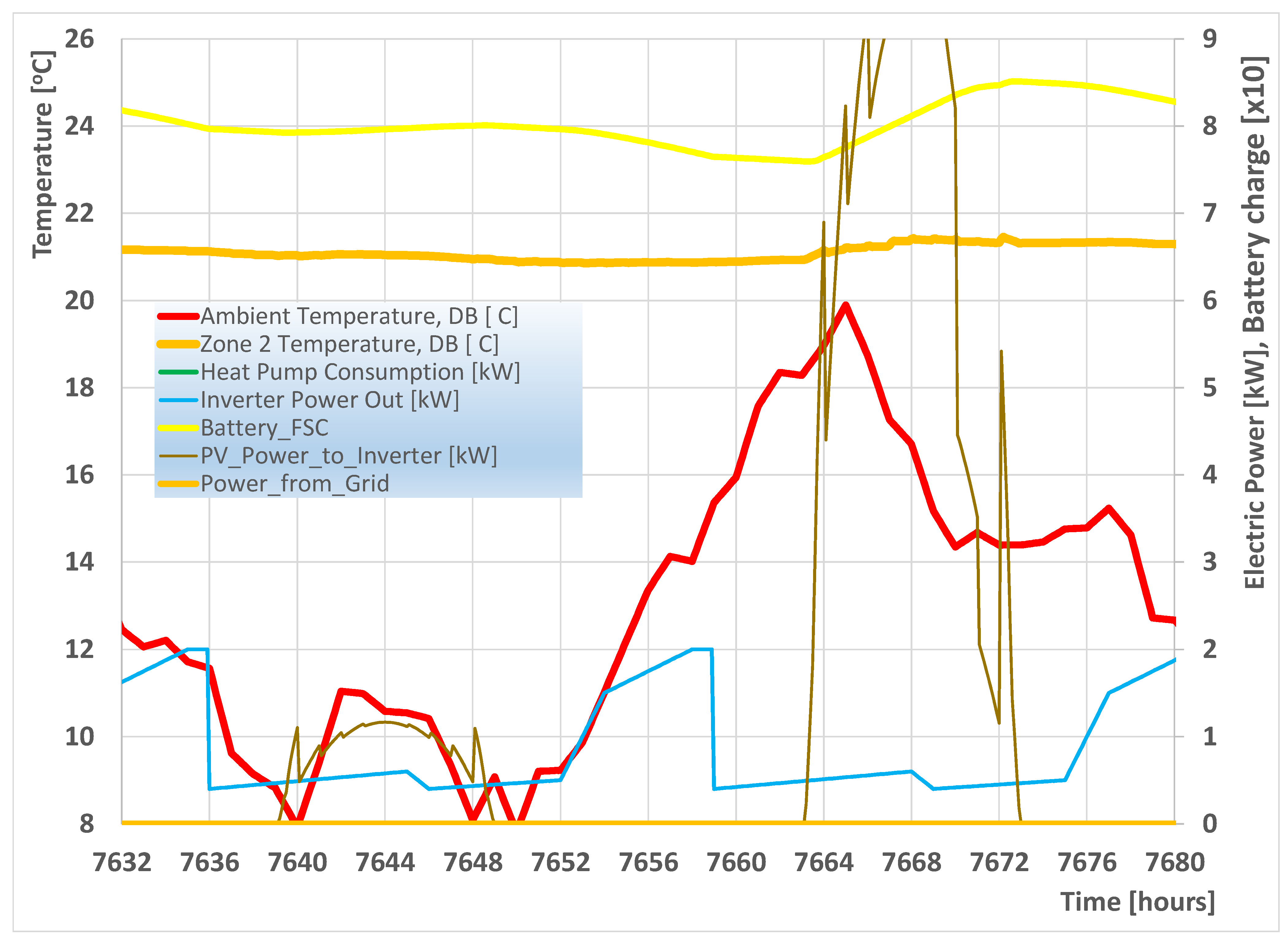
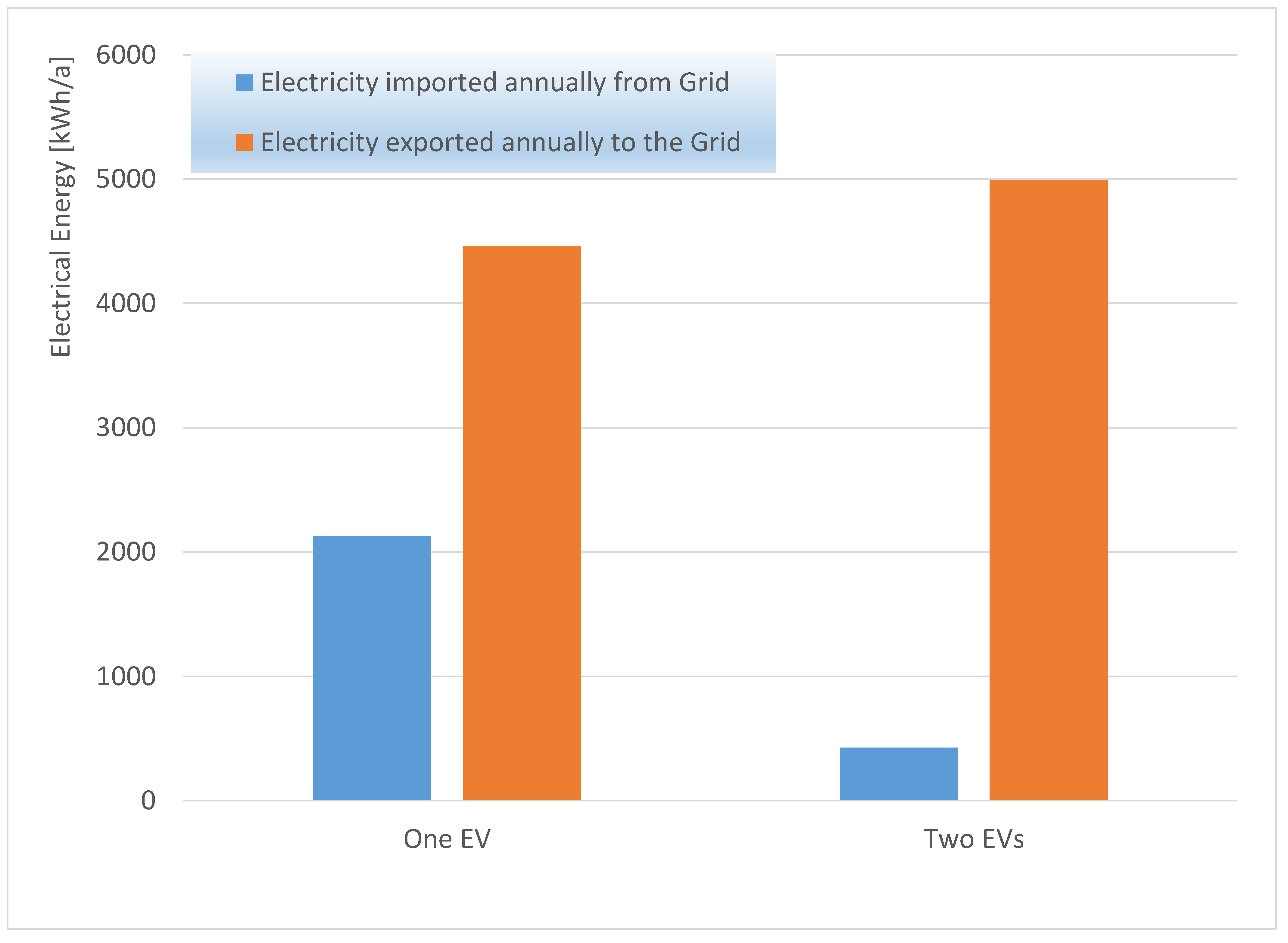

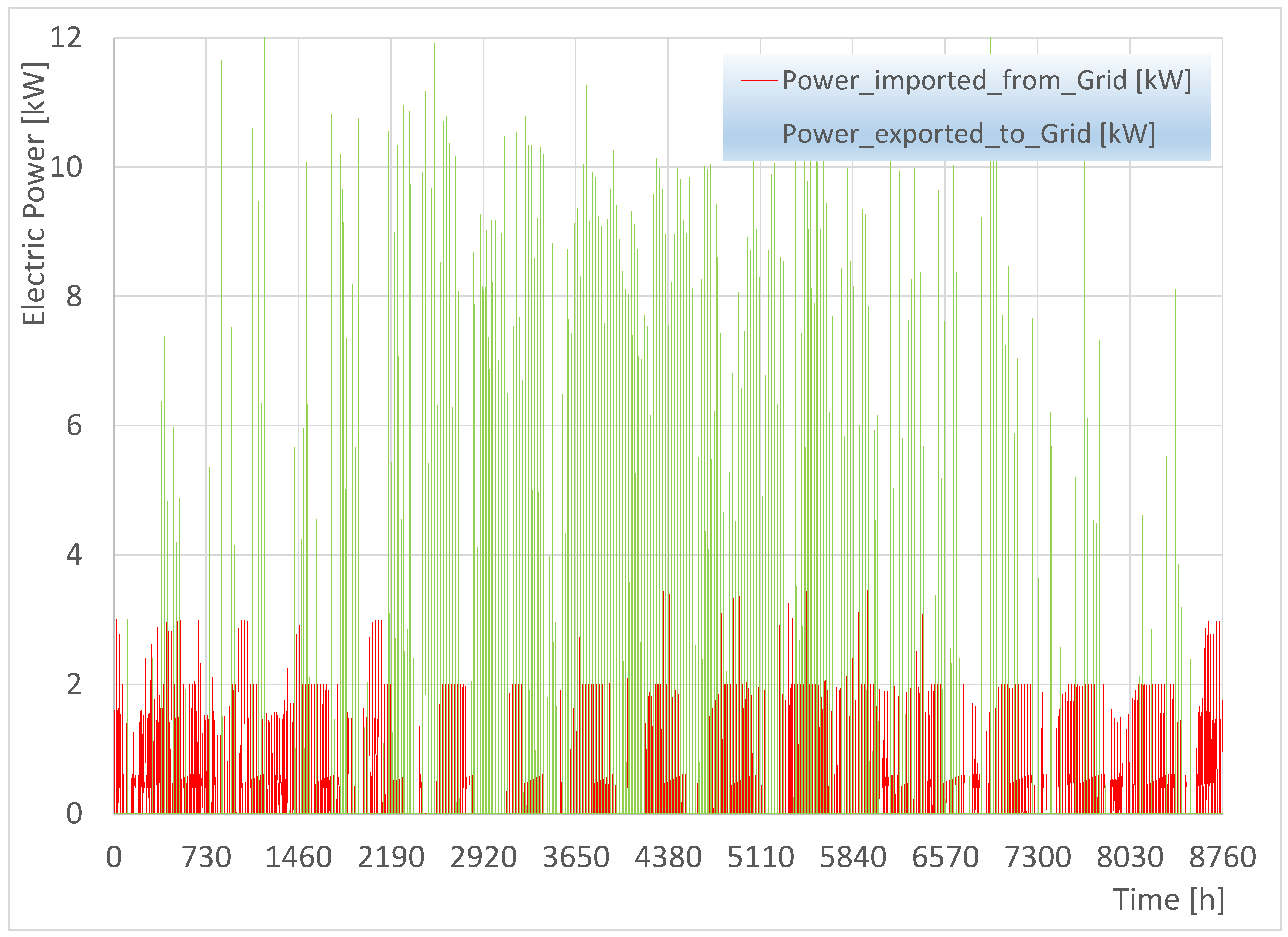
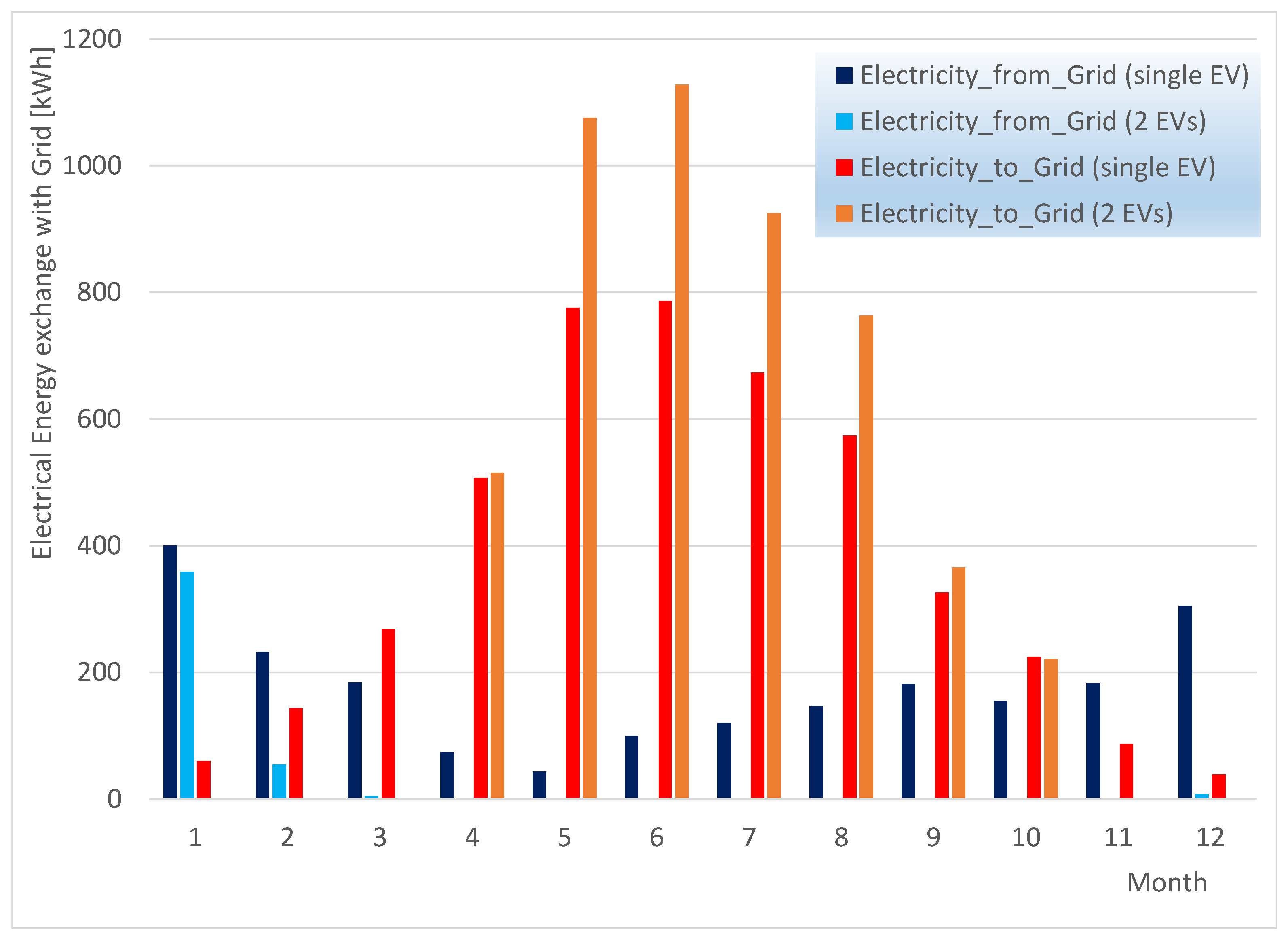
| Parameter | IL,ref | I0,ref | RS | RSH | a |
|---|---|---|---|---|---|
| Value | 9.705 A | 0.2991 nA | 0.06054 Ω | 5000 Ω | 2.664 |
| PV Module Parameter | Value | Comments |
|---|---|---|
| ISC at STC | 1154 A | Short circuit current |
| VOC at STC | 40.81 V | Open circuit voltage |
| IMPP at STC | 10.75 A | Current at max power point |
| VMPP at STC | 34.42 V | Voltage at max power point |
| Temp. coefficient of ISC (STC) | 0.057%/K | αISC |
| Temp. coefficient of VOC (STC) | −0.263%/K | βVOC |
| Number of cells wired in series | 2 strings × 60 | modules |
| Module temperature at NOCT | 318 K | |
| Ambient temperature at NOCT | 293 K | |
| Module area | 1.85 m2 | |
| Module efficiency | 20.0% |
Publisher’s Note: MDPI stays neutral with regard to jurisdictional claims in published maps and institutional affiliations. |
© 2022 by the authors. Licensee MDPI, Basel, Switzerland. This article is an open access article distributed under the terms and conditions of the Creative Commons Attribution (CC BY) license (https://creativecommons.org/licenses/by/4.0/).
Share and Cite
Stamatellos, G.; Zogou, O.; Stamatelos, A. Interaction of a House’s Rooftop PV System with an Electric Vehicle’s Battery Storage and Air Source Heat Pump. Solar 2022, 2, 186-214. https://doi.org/10.3390/solar2020011
Stamatellos G, Zogou O, Stamatelos A. Interaction of a House’s Rooftop PV System with an Electric Vehicle’s Battery Storage and Air Source Heat Pump. Solar. 2022; 2(2):186-214. https://doi.org/10.3390/solar2020011
Chicago/Turabian StyleStamatellos, George, Olympia Zogou, and Anastassios Stamatelos. 2022. "Interaction of a House’s Rooftop PV System with an Electric Vehicle’s Battery Storage and Air Source Heat Pump" Solar 2, no. 2: 186-214. https://doi.org/10.3390/solar2020011
APA StyleStamatellos, G., Zogou, O., & Stamatelos, A. (2022). Interaction of a House’s Rooftop PV System with an Electric Vehicle’s Battery Storage and Air Source Heat Pump. Solar, 2(2), 186-214. https://doi.org/10.3390/solar2020011







